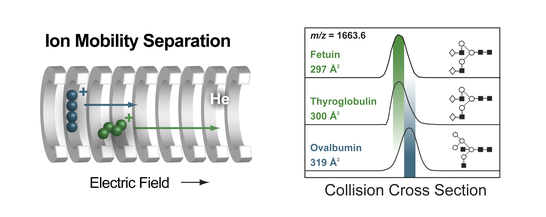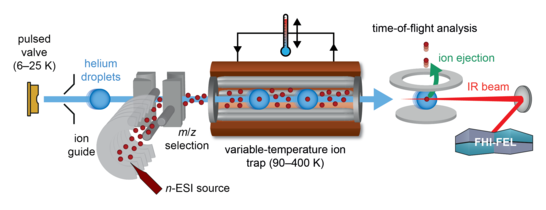Ion Mobility-Mass Spectrometry and Cold-Ion Spectroscopy of Carbohydrates
Glycosylation is one of the most common and diverse post-translational modifications occurring in proteins. The involved carbohydrates, the glycans, are responsible for a variety of biological functions including apoptosis, cell-cell-recognition and immune response and are therefore linked to various diseases. The intrinsic chemical complexity and often identical mass of carbohydrates makes their direct structural identification on basis of conventional tandem mass spectrometric data challenging. To overcome these problems, we combine mass spectrometry (MS) with ion mobility (IM) spectrometry, which serves as an additional “gas-phase chromatography” step in which ions are not only separated according to their mass and charge, but also their size and shape. This allows the separation of regio- and stereoisomers and yields an additional structural parameter in form of the rotationally averaged collision cross section (CCS). Experiments are performed on a commercially available hybrid tandem IM-MS instrument (Synapt G2-S) in which the ions of interest can be fragmented prior or after IM separation.

Gas-phase spectroscopy is a powerful tool when studying the structure of isolated molecules, and can deliver critical information regarding the intra- and intermolecular interactions within such systems. In combination with ab initio calculations, the obtained spectra enable the structural elucidation and assignment of the preferred conformations. Here, we conduct experiments on a home-built instrument that combines nano-electrospray ionization (n-ESI), mass spectrometry and cold-ion IR spectroscopy. Thermal contributions can be largely neglected due to the sub-Kelvin environment of superfluid helium droplets. In combination with the narrow-bandwidth Fritz Haber Institute free-electron laser (FHI-FEL), IR spectral fingerprints with an unprecedented resolution can be obtained. This method enables the unambiguous identification of the smallest structural variations of mass-selected, complex glycans and even distinguish extremely similar isomeric species. The highly reproducible IR spectra allows to study and compare the IR signatures of not only intact glycan ions, but also of their characteristic fragments.

Downloads
- Excel spreadsheet to estimate CCSs from traveling wave ion mobility mass spectrometry data. See file for further details and literature.
- pdf with step-by-step description of the instrument optimization and calibration procedure.
Related Publications to IM-MS of Carbohydrates
- Glycan analysis by ion mobility-mass spectrometry and gas-phase spectroscopy
Manz, C.; Pagel, K.; Curr. Opin. Chem. Biol. 2018, 42, 16–24. - Collision Cross Sections and Ion Mobility Separation of Fragment Ions from Complex N-glycans
Harvey, D. J.; Watanabe, Y.; Allen, J.; Rudd, P.; Pagel, K.; Crispin, M.; Struwe, W. B, J. Am. Soc. Mass Spectrom. 2018, 29, 1250–1261. - Glycan Analysis by Ion Mobility-Mass Spectrometry
Hofmann, J.; Pagel, K., Ang. Chem. lnt. Ed. 2017, 56, 8342–8349. - Identification of Lewis and blood group carbohydrate epitopes by ion mobility-tandem-mass spectrometry fingerprinting
Hofmann, J.; Stuckmann, A.; Crispin, M.; Harvey, D. J.; Pagel, K.; Struwe, W. B., Anal. Chem. 2017, 89, 2318–2325. - Ion mobility separation of deprotonated oligosaccharide isomers - evidence for gas-phase charge migration
Struwe, W. B.; Baldauf, C.; Hofmann, J.; Rudd, P. M.; Pagel, K.; Chem. Commun. 2016, 52, 12353–12356. - Distinguishing N-acetylneuraminic acid linkage isomers on glycopeptides by ion mobility-mass spectrometry
Hinneburg, H.; Hofmann, J.; Struwe, W. B.; Thader, A.; Altmann, F.; Varón Silva, D.; Seeberger, P.; Pagel, K.; Kolarich, D.; Chem. Commun. 2016, 52, 4381–4384. - Identification of carbohydrate anomers using ion mobility–mass spectrometry
Hofmann, J.; H. S. Hahm, P. H. Seeberger; Pagel, K.; Nature 2015, 526, 241–244. - Estimating collision cross sections of negatively charged N-glycans using traveling wave ion mobility-mass spectrometry
Hofmann, J.; Struwe, W.B.; Scarff, C.A.; Scrivens, J.H.; Harvey, D.J.; Pagel, K.; Anal. Chem. 2014, 86, 10789–10795. - Ion mobility-mass spectrometry of complex carbohydrates: Collision cross sections of sodiated N-linked glycans
Pagel, K.; Harvey, D.J.; Anal. Chem. 2013, 85, 5138–5145.
Related Publications to Cold-Ion Spectroscopy of Carbohydrates
- The Role of the Mobile Proton in Fucose Migration
Lettow, M.; Mucha, E.; Manz, C.; Thomas, D. A.; Marianski, M.; Meijer, G.; von Helden, G.; Pagel, K.; Anal. Bioanal. Chem. 2019, DOI: 10.1007/s00216-019-01657-w. - In-Depth Structural Analysis of Glycans in the Gas Phase
Mucha, E.; Stuckmann, A.; Marianski, M.; Struwe, W. B.; Meijer, G.; Pagel, K.; Nature Commun. 2019, 10, 1272–1284. - Unraveling the Structure of Glycosyl Cations via Cold-Ion Infrared Spectroscopy
Mucha, E.; Marianski, M.; Xu, F.-F.; Thomas, D. A.; Meijer, G.; von Helden, G.; Seeberger, P. H.; Pagel, K.; Nature Commun. 2018, 9, 4174. - Fucose Migration in Intact Protonated Glycan Ions – A Universal Phenomenon in Mass Spectrometry
Mucha, E.; Lettow, M.; Marianski, M.; Thomas, D.A.; Struwe, W. B.; Harvey, D. J.; Meijer, G.; Seeberger, P. H.; von Helden, G.; Pagel, K.; Angew. Chem. Int. Ed. 2018, 57, 7440–7443. - Glycan Fingerprinting using Cold-Ion Infrared Spectroscopy
Mucha, E.; González Flórez, A. I; Marianski, M.; Thomas, D. A.; Hoffmann, W.; Struwe, W. B.; Hahm, H. S.; Gewinner, S.; Schöllkopf, W.; Seeberger, P. H.; von Helden, G.; Pagel K.; Angew. Chem. Int. Ed. 2017, 56, 11248–11251.




